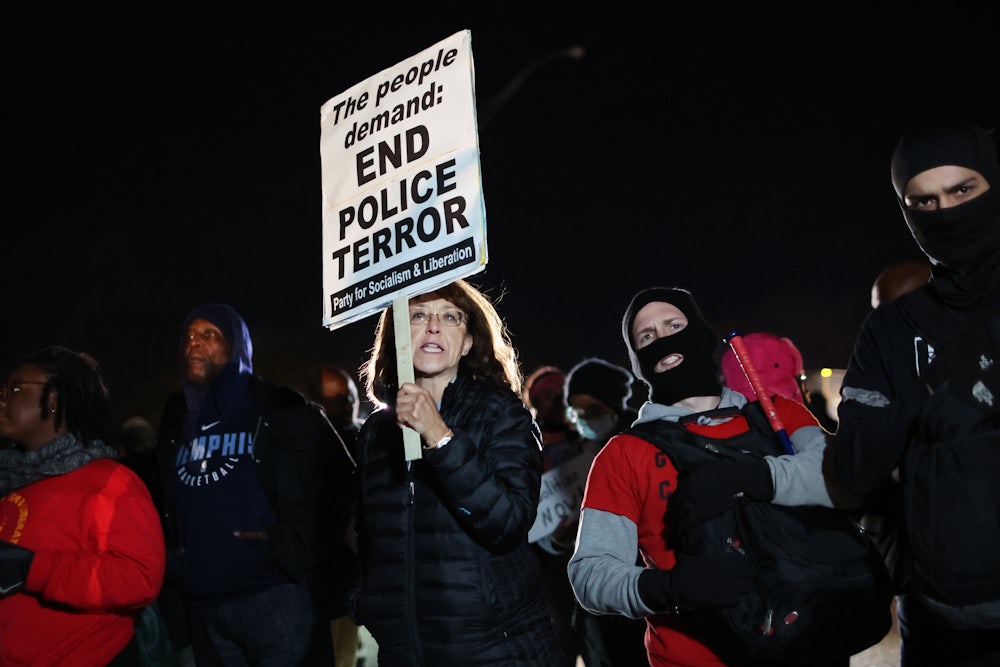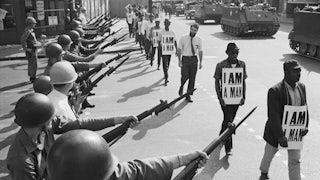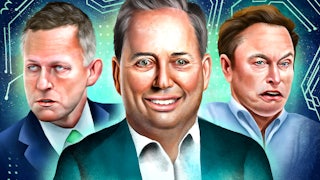Last Friday, news outlets across the country braced the nation for the Memphis Police Department’s release of the video showing five Black officers police beating Tyre Nichols, a 29-year-old Black man. The assault resulted in Nichols’s death three days later.
The warnings that preceded the release of footage felt more sensational than advisory, as if hyping up the public for the last trailer for the next Marvel movie. At nearly every commercial break, MSNBC host Ari Melber reminded viewers of how appalling the footage was and that the network would show it. “Many around the nation are bracing for the release of the video,” Melber said before describing it as “appalling,” “inhumane,” and “sickening.”
The media presented the footage as if it were a sequel to the 1991 Rodney King film, and like many sequels, the Nichols footage would be more grotesque, harrowing, and unbearable, with a plot twist: All the officers are Black. Ed Obayashi, a northern California sheriff’s deputy, described the video as “worse than Rodney King.” (I’m not sure what metrics are used to conclude the sadism of Nichols’s beating is worse than King’s.)
Joy Reid introduced the Nichols video by cautioning that the utility of the footage is not “prurience.” Reid explained that the video’s utility is awareness and accountability. “We’re going to show you the video because you pay for the police,” Reid said. Indeed, the police are public servants. But what if the violence inflicted on Black Americans for public consumption is the service to the public?
The videos allow non-Black people to ease their anxiety about police violence because the footage reassures them that the violence they witness only happens to Black people. Because the assaults on civilians become a “Black thing,” society is less inclined to end it—even though white people are also victims of police violence—and perpetuates the cycle.
As activist and professor of African American studies at UC Irvine, Frank Wilderson III says, “White people know they are white because they know they are not Black.”
“What we are witnessing on YouTube, Instagram, and the nightly news as murders are rituals of healing for civil society,” Wilderson explains in his 2020 book Afropessimism. “Rituals that stabilize and ease the anxiety that other people feel in their daily lives.… I know I am a Human because I am not Black. I know I am not Black because when and if I experience the kind of violence Blacks experience there is a reason, some contingent transgression.”
This explains why videos of white Americans murdered by the police do not have the same utility as when the victim is Black. This might explain why the slaughter of Daniel Shaver did not garner attention in the media. White people tend not to see their existence as antagonistic to the country, so when they are gripped into the folds of police violence, their experience can be appraised as individual strife, allowing them to distance themselves from the tragedy of police violence with a logic: Structural violence does not happen to me because I am not Black. If the police did harm me, there must be a reason.
Perhaps this is why the 2015 murder of 6-year-old Jeremy Mardis, a white autistic child who was killed by law enforcement officers in Marksville, Louisiana, was not repeated in the media and did not result in mass protests around the country, as Chauncey DeVega noted for Salon in 2016. “As compared with incidents of police violence against black and brown people,” Devega wrote, “in this case Stafford and Greenhouse were quickly charged with murder. The justice system failed Jeremy Mardis but it’s trying to remedy that mistake by punishing the two officers who killed him.”
The mental health of the country is so dependent on Black death, that the murder—as if by firing squad—of a white 6-year-old child didn’t quite rouse the American consciousness into a fierce protest—not like the shooting of 12-year-old Tamir Rice or the lynching of Emmett Till. If white Americans were subjected to repeated images of their demise by police, they might have to do something—say defund the police—but that would mean moving toward ending violence in general so that it doesn’t happen to Black people specifically. If that happened, how would white people know they are white?
One might suggest that when someone is close to violence, it becomes difficult to watch. Black Americans have reproduced imagery of our own demise to no avail because the gulf between empathy and Black Americans is vast. That is why reading first-person accounts of slavery did not end slavery. Images of lynching did not eliminate lynching. Videos of police gunning down unarmed Black Americans has not stopped police shootings.
The trauma videos can inflict on Black Americans is well documented. From this perspective, the videos are problematic reminders of the threat of violence that underwrites Black life. On the other hand, a case has been made that videos of police shootings have an evidentiary function in that they help illuminate the ubiquity of police brutality inflicted on Black Americans and can serve as evidence in court. This was certainly the case with Ahmaud Arbery, as without the video his killers would have never been charged with hunting and executing him. But since Arbery’s murderers weren’t police, their convictions say more about the problem with qualified immunity and the presumption of innocence and benefit of doubt police receive.
I tend to agree with Ja’han Jones who criticized the efficacy of the videos as sympathy or knowledge production. “In this scenario, Black justice hinges entirely on white sympathy,” Jones wrote. “And it leads you to the situation we seem to be in now, with repeated incidents of recorded police violence terrorizing Black people, while casting doubt on whether this sympathy will ever rise to a level needed to spur lasting change.”
I was born in the 1980s, so I remember when rap lyrics were criticized for being too violent and perpetuating the same violence rappers said they were reporting. I remember the paranoia that violent video games caused school shootings. I remember warnings that constant viewing of pornography would entice a viewer to seek more extreme instances of sexual imagery. What are we to make of videos of violence against Black Americans by law enforcement? Is it possible that the imagery is perpetuating the violence cameras are supposed to disrupt? Have we not seen an escalation in the brutality, moving from shootings to choking, to now the use of bare hands to beat a handcuffed victim to death?
I remember the proclamations that videos of police officers killing Black Americans have triggered a “reckoning” on race in America. This is not true. Supposedly, Trayvon Martin caused a “reckoning.” Michael Brown caused a reckoning. The murder of Philando Castille caused a reckoning. And now I am numb to the suggestion that Nichols’s will trigger a reckoning.
Either this country is addicted to reckoning or it is addicted to the psychic need to view images of violence inflicted on Black people. In either case, at what point do we rethink the cost Black Americans pay to be the stimulus for consciousness in white people?


